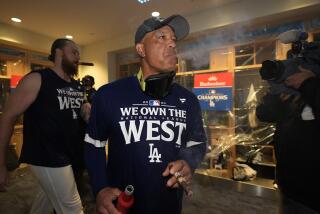Quick-Fixes Put the AL East in Quite a Fix
In case you haven’t been paying attention to anything other than the Orioles’ captivating play of late, the American League’s Eastern Division has already received a stern message.
And it has nothing to do with the local team’s surprising appearance in first place.
Remember when they used to refer to the divisions as the American League East and the American League Least (or Worst)? Well, that has been gradually changing over the last five seasons and it’s now official: The joke has moved to the other coast.
It has been more than a decade (1977) since the American League West posted a winning record against the American League East, but that is about to change and it could get ugly.
There were times when the fourth- and fifth-place teams on the east side of the country had records good enough to challenge, if not beat, the best in the west.
For instance, in 1976 the Orioles won 88 games and finished 10 1/2 games out; two years later they won 90 and were nine games back. As recently as 1984, when they started to slide, the Orioles managed 85 wins (fifth place, 19 games out), and the next year they won 83 (fourth, 16 games behind).
Now, we at least have an idea that a major reason the Orioles crashed so rapidly was the steady improvement of the teams in the West. The Orioles just got the message before the rest of their division.
Barely 10 percent of the 1989 season has been played and already the Western Division teams are 14 games over .500 against teams from the East. Chances are strong this isn’t a fluke.
Last year, Minnesota won 91 games, more than any team in the East, and finished 13 games behind Oakland. Remember we’re talking about a “balanced” schedule here, where a team plays four more games per year against the “other” division.
There was only a five-game difference between the two divisions in 1988, the closest the two have been in 11 years.
Since 1981, every team in the American League East except Cleveland has won a title, with Boston the only team to do it twice.
The American League East produced pennant winners in nine of 10 years (1975-84) and was classified as the dominant division in baseball.
However, halfway through the decade, parity replaced power in the East. Meanwhile, Kansas City, Minnesota and Oakland were developing in the West.
In the last four seasons, only the 1986 Red Sox have given the East an American League champion. Boston won the division again last year (89 wins), but the 3 1/2 games that separated the first- and fifth-place teams showed that mediocrity had taken over.
So, what happened to the mighty American League East? It’s called what goes around, comes around. The American League West is showing its first signs of muscle since the age of free agency.
And that is probably another message for the American League East, where power-parity-mediocrity has every team looking for the quick fix.
The easiest way to explain the rise of the West -- specifically the Royals, Twins and A’s, and more recently the Texas Rangers and California Angels -- is the number of high draft choices they have accumulated over the lean years.
But, a bigger reason is the retention of those draft choices.
For the most part, the American League East “pretenders” have relied to a great extent on free agent help, giving up amateur draft choices that provide organizational continuity and long-range stability.
A late first-round pick is better than none at all.
The Orioles, perhaps more than any other team, have been on both sides of that dilemma.
In 1978, because they lost pitchers Ross Grimsley and Dick Drago and outfielder Elliott Maddox to free agency, they picked up three extra draft choices to stock a farm system that was just starting to show signs of decay.
In 1984, only one year after winning the World Series and coming off an 85-win season, the Orioles made what appeared to be a logical short-term move and signed free agents Fred Lynn, Don Aase and Lee Lacy.
As a result, they lost their first three draft choices in 1985.
That proved to be devastating, because they had already surrendered a No. 1 in 1984 (for Tom Underwood) and their first two picks in 1981 (for Jim Dwyer and Jose Morales).
The Yankees haven’t had a significant draft since Jimmy Carter was president. Not coincidentally, they haven’t won a division title since 1981.
It’s no accident that the two teams with the most talent in the American League East, Toronto and Boston, have stayed within the system.
So has Cleveland, but the Indians were dormant for so long that the process has seemed eternal.
Milwaukee bottomed out in much the same fashion as the Orioles, with a solid team that took the natural course and phased itself out. Detroit appears only a heartbeat away from following that same pattern.
The Brewers have made a relatively painless recovery, and much faster than the Orioles, by staying within the organization.
It will remain to be seen how the Tigers react to their seemingly inevitable fall, but General Manager Bill Lajoie has already taken notice.
“I don’t want the same thing to happen to us that happened to the Orioles,” Lajoie said.
The moral of the story is that the quick fix makes sense only as an occasional option. If you don’t think so, just ask the Orioles.
Or better still, ask the New York Mets, another team whose progress can be traced to the minor-league system. Once upon a time, in 1977, the Mets felt Maddox could fortify their outfield.
Had they refrained from the urge to patch their outfield, the Mets might have drafted an infielder who could have been the glue on a team that still might be the best of this generation.
There is no guarantee that the Mets would have had the foresight to select Cal Ripken, but he would have been available.
With the Mets’ second-round choice, obtained when Maddox took the free agent route, the Orioles drafted Larry Sheets and later tabbed Ripken with their own selection.
Elliott Maddox for Cal Ripken? Think about that one.
That’s the kind of message the American League East should be getting from the American League West.
The imbalance isn’t going to be solved overnight -- and it will take some teams a lot longer if they insist on a series of short-term investments.
Just ask the Orioles -- or the Mets.
More to Read
Go beyond the scoreboard
Get the latest on L.A.'s teams in the daily Sports Report newsletter.
You may occasionally receive promotional content from the Los Angeles Times.










